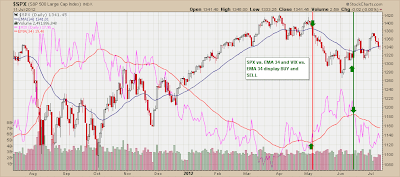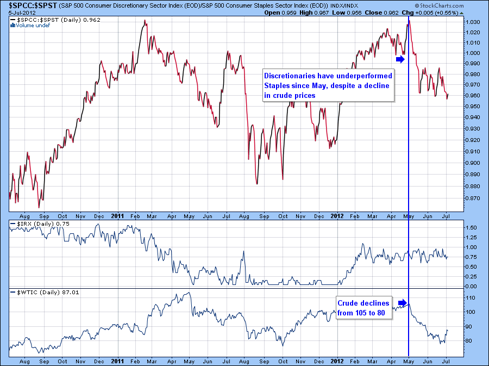From an historical perspective spanning the last 55 years, the S&P500 is at a valuation level matching the lows experienced before the launch of the bullish stock market run that started in the early 1980’s and peaked in early 2000.
To collect this data, I went to FRED, the Federal Reserve Economic Data maintained by the Federal Reserve of St. Louis. I plotted the S&P500 plus a plot of the index divided by seasonally-adjusted After Tax Corporate Profits to arrive at a proxy PE ratio.
As the chart below shows, although the S&P500 is 10% below its 2000 peak, valuations today are 71% lower than the valuations reached in 2000 (the blue line is the PE ratio and the red line is the S&P500 index). Note how the PE ratio is aligned with levels last seen in the early-mid 1980’s. Compared to the 2007 peak, the S&P500 is 12% lower, yet valuations are cheaper by about 30%.
This data raises a couple of immediate observations:
1. Stocks are extraordinarily cheap. The significant earnings power that corporations have generated from secular economic trends in productivity and globalization has outpaced stock price growth. It would appear that stock prices need to catch up. At a minimum, it may suggest that stock prices are fairly well-protected on the downside, an opportunity for long-term investors. As historically low interest rates benefit corporations and consumers, as well as raise the risk of an asset bubble in fixed income investments, perhaps stocks are the screaming buy alternative. Many workers who entered the labor force in the early 1980’s (like me) saw stock portfolios rise consistently up to the 2000 peak. Perhaps today’s workforce entrants will experience a similar long-term ride.
2. Investors are less willing to bid up stock prices commensurate with earnings growth. This may suggest waning participation from retail investors or simply skepticism and fear that something terrible is about to happen (i.e. the implosion of the Eurozone). Perhaps these historically low valuations are suggesting that stock prices and the financial markets in general are preparing to collapse, warning of a deflationary environment and a market not unlike that experienced by Japan over a 20+ year span. The lack of enthusiasm to bid up prices as earnings grow may suggest a sea of bearishness as well as skepticism and outright contempt of the stock market. But that too feels like a long-term contrarian “buy” signal.
I then took the FRED data and decided to see how an interest rate-adjusted PE ratio compared historically to stock prices. Since interest rates are so low, and the earning yield relative to interest rates is another popular valuation indicator, I chose to multiply the PE ratio by the Federal Funds Rate, which today is 0.25%, to see how this measure of valuation stacks up historically.
As you can see by the chart below, replacing the blue line in the above chart (our PE ratio) with a line modified by the Federal Funds Rate tells us that valuations are at their lowest in the 55-year history that the Federal Reserve has been collecting this data.
That suggests serious undervaluation of stocks. Such a dismal valuation is either a precursor to Armageddon in the financial markets, or a great secular buying opportunity.
Secular markets have historically lasted 10 to 15 years. The market peak in 2000 has been popularly considered the start of a secular bear market that is now pushing 13 years in age. Unless a market rout is in the cards to take this secular bear market to another significant decline to complete the bearish secular trend, today’s valuations suggest that a slow and steady buildup of a portfolio of equities may be a prudent long-term investment strategy, one that rewarded investors following the secular bear market of the 1970’s.

















